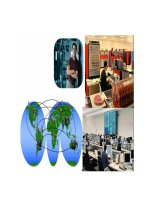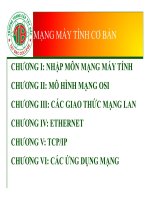HỆ THỐNG cáp của LAN và WAN (MẠNG máy TÍNH cơ bản SLIDE)
Bạn đang xem bản rút gọn của tài liệu. Xem và tải ngay bản đầy đủ của tài liệu tại đây (2.58 MB, 127 trang )
Chương 5
HỆ THỐNG CÁP CỦA LAN VÀ WAN
CABLING LAN AND WAN
Overview
• Even though each local-area network is
unique, there are many design aspects
that are common to all LANs. For example,
most LANs follow the same standards and
the same components. This module
presents information on elements of
Ethernet LANs and common LAN devices.
Computer Network
1
• There are several wide-area network
(WAN) connections available today. They
range from dial-up to broadband access,
and differ in bandwidth, cost, and
required
equipment.
This
module
presents information on the various
types of WAN connections.
Computer Network
2
• Students completing this module should
be able to:
– Identify
characteristics
of
Ethernet
networks.
– Identify straight-through, crossover, and
rollover cables.
– Describe the function, advantages, and
disadvantages of repeaters, hubs, bridges,
switches,
and
wireless
network
components.
– Describe the function of peer-to-peer
networks.
Computer Network
3
– Describe the function, advantages, and
disadvantages of client-server networks.
– Describe and differentiate between serial,
Integrated Services Digital Network
(ISDN), digital subscriber line (DSL), and
cable modem WAN connections.
– Identify router serial ports, cables, and
connectors.
– Identify and describe the placement of
equipment used in various WAN
configurations.
Computer Network
4
5.1. Cabling the LAN
5.1.1. LAN physical layer
• Various symbols are used to represent
media types. Token Ring is represented
by a circle. Fiber Distributed Data
Interface (FDDI) is represented by two
concentric circles and the Ethernet
symbol is represented by a straight line.
Serial connections are represented by a
lightning bolt.
Computer Network
5
Computer Network
6
• Each computer network can be built with
many different media types. The function
of media is to carry a flow of information
through a LAN. Wireless LANs use the
atmosphere, or space, as the medium.
Other networking media confine network
signals to a wire, cable, or fiber.
Networking media are considered Layer
1, or physical layer, components of LANs.
Computer Network
7
• Each media has advantages and
disadvantages. Some of the advantage or
disadvantage comparisons concern:
– Cable length
– Cost
– Ease of installation
– Susceptibility to interference
• Coaxial cable, optical fiber, and even free
space can carry network signals.
However, the principal medium that will
be studied is Category 5 unshielded
twisted-pair cable (Cat 5 UTP) which
includes the CatComputer
5e family
of cables.
Network
8
• Many topologies support LANs, as well
as many different physical media. The
figure shows a subset of physical layer
implementations that can be deployed to
support Ethernet.
Computer Network
9
Computer Network
10
5.1.2. Ethenet trong khn viên trường học
(Ethernet in the campus)
• Ethernet is the most widely used LAN
technology.
Ethernet
was
first
implemented by the Digital, Intel, and
Xerox group, referred to as DIX. DIX
created and implemented the first Ethernet
LAN specification, which was used as the
basis for the Institute of Electrical and
Electronics
Engineers
(IEEE)
802.3
specification, released in 1980.
Computer Network
11
• Later, the IEEE extended 802.3 to three
new committees known as 802.3u (Fast
Ethernet), 802.3z (Gigabit Ethernet over
Fiber), and 802.3ab (Gigabit Ethernet
over UTP).
• Network requirements might dictate
that an upgrade to one of the faster
Ethernet topologies be used. Most
Ethernet networks support speeds of
10 Mbps and 100 Mbps.
Computer Network
12
• The new generation of multimedia,
imaging, and database products, can
easily overwhelm a network running at
traditional Ethernet speeds of 10 and
100 Mbps. Network administrators may
consider providing Gigabit Ethernet
from the backbone to the end user.
Costs for installing new cabling and
adapters can make this prohibitive.
Gigabit Ethernet to the desktop is not a
standard installation at this time.
Computer Network
13
• In general, Ethernet technologies can be
used in a campus network in several
different ways:
– An Ethernet speed of 10 Mbps can be
used at the user level to provide good
performance. Clients or servers that
require more bandwidth can use 100Mbps Ethernet.
– Fast Ethernet is used as the link between
user and network devices. It can support
the combination of all traffic from each
Ethernet segment.
Computer Network
14
– To enhance client-server performance
across the campus network and avoid
bottlenecks, Fast Ethernet can be used
to connect enterprise servers.
– Fast Ethernet or Gigabit Ethernet, as
affordable, should be implemented
between backbone devices
Computer Network
15
Computer Network
16
5.1.3. Nhu cầu đường truyền Ethenet và bộ
nối (Ethernet media and connector
requirements)
• Before
selecting
an
Ethernet
implementation, consider the media and
connector
requirements
for
each
implementation. Also, consider the level
of performance needed by the network.
Computer Network
17
• The cables and connector specifications
used
to
support
Ethernet
implementations are derived from the
Electronic Industries Association and
the
Telecommunications
Industry
Association (EIA/TIA) standards body.
The categories of cabling defined for
Ethernet are derived from the EIA/TIA568 (SP-2840) Commercial Building
Telecommunications Wiring Standards.
Computer Network
18
• The figure compares the cable and
connector specifications for the most
popular Ethernet implementations. It is
important to note the difference in the
media used for 10-Mbps Ethernet versus
100-Mbps Ethernet. Networks with a
combination of 10- and 100-Mbps traffic
use UTP Category 5 to support Fast
Ethernet.
Computer Network
19
Computer Network
20
5.1.4. Mơi trường kết nối (Connection
media)
• The figure illustrates the different
connection types used by each physical
layer implementation. The registered
jack (RJ-45) connector and jack are the
most common. RJ-45 connectors are
discussed in more detail in the next
section.
Computer Network
21
• In some cases the type of connector on a
network interface card (NIC) does not match
the media that it needs to connect to. As
shown in Figure, an interface may exist for the
15-pin attachment unit interface (AUI)
connector. The AUI connector allows different
media to connect when used with the
appropriate transceiver. A transceiver is an
adapter that converts one type of connection
to another. Typically, a transceiver converts an
AUI to RJ-45, coax, or fiber optic connector. On
10BASE5 Ethernet, or Thicknet, a short cable
is used to connect the AUI with a transceiver
on the main cable. Computer Network
22
Computer Network
23
5.1.5. Thực hiện UTP (UTP implementation)
• EIA/TIA specifies an RJ-45 connector for UTP
cable. The letters RJ stand for registered jack,
and the number 45 refers to a specific wiring
sequence. The RJ-45 transparent end
connector shows eight colored wires. Four of
the wires carry the voltage and are considered
“tip” (T1 through T4). The other four wires are
grounded and are called “ring” (R1 through
R4). Tip and ring are terms that originated in
the early days of the telephone. Today, these
terms refer to the positive and the negative
wire in a pair. The wires in the first pair in a
cable or a connector are designated as T1 and
R1. The second pair
is T2
and R2, and so on. 24
Computer
Network
• The RJ-45 connector is the male
component, crimped on the end of the
cable. When looking at the male connector
from the front, the pin locations are
numbered 8 on the left down to 1 on the
right as seen in Figure.
Computer Network
25









